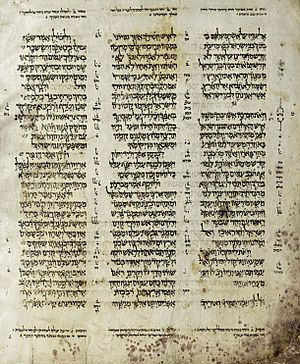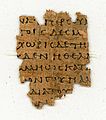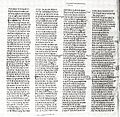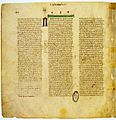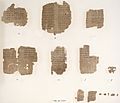Biblical manuscript facts for kids
A Biblical manuscript is a handwritten copy of any part of the Bible. These copies come in many sizes. Some are small scrolls with just a few verses from the Jewish scriptures. Others are huge books called codices that contain both the Hebrew Bible (Tanakh) and the New Testament, plus other writings.
Ancient Hebrew Bible Copies
The Aleppo Codex (made around 920 AD) and the Leningrad Codex (around 1008 AD) were once the oldest known Hebrew copies of the Tanakh. But then, in 1947, something amazing happened! The Dead Sea scrolls were found at Qumran. This discovery pushed the history of the Tanakh's manuscripts back by about 1,000 years.
Before the Dead Sea Scrolls, the oldest complete copies of the Old Testament were in Greek. These included manuscripts like Codex Vaticanus and Codex Sinaiticus. Out of about 800 manuscripts found at Qumran, 220 are from the Tanakh. Almost every book of the Tanakh is there, except for the Book of Esther. However, most are only small pieces.
Two important scrolls of the Book of Isaiah were found. One is complete (1QIsa), and another is about 75% complete (1QIsb). These scrolls were generally made between 150 BC and 70 AD. Ancient Jewish scribes (people who copied texts) had many special ways to make sure their copies were correct.
New Testament Copies

More copies of the New Testament have been saved than any other ancient book. There are over 5,800 complete or broken Greek copies. Plus, there are 10,000 Latin copies and 9,300 copies in other old languages. These include Syriac, Slavic, Gothic, Ethiopic, Coptic, and Armenian.
These manuscripts were made from about 125 AD until printing began in Germany in the 1400s. Most of them are from after the year 1000. Even though there are many New Testament manuscripts, the text in the later copies might not be exactly the same as the very first writings.
A scholar named Bart Ehrman explained that while there are many New Testament copies, most are from many centuries after the originals. He noted that none of them are perfectly exact. They all have small differences. Because of this, it's a big job to figure out the exact original words of the New Testament.
Bruce M. Metzger, another scholar, talked about how much evidence there is for the New Testament. He said that for comparison, Homer's Iliad has 457 papyrus copies and 190 other manuscripts. The works of Euripides have 54 papyrus copies and 276 parchment manuscripts. The time between when the New Testament books were written and when the oldest copies were made is quite short. It's often only about a century. For many classical writers, there's a gap of 1,000 years or more.
Every year, new New Testament manuscripts written in the original Greek are still being found.
Images for kids
-
The beginning of the Gospel of Mark from the Book of Durrow.
-
A page from the Sinope Gospels. The small picture at the bottom shows Jesus healing a blind person.
-
An illustration of a European scribe (a person who copies books) at work.
-
Pieces of the Dead Sea scrolls on display at the Archeological Museum in Amman.
-
𝔓52 is the oldest known piece of a New Testament manuscript. It has part of the Gospel of John.
-
𝔓46 is the earliest almost complete manuscript of the letters written by Paul in the New Testament.
-
𝔓87 is the earliest known manuscript of Philemon.
-
𝔓37 is a piece of the Gospel of Matthew that includes special holy names.
-
𝔓1 is an early third-century piece of the Gospel of Matthew.
-
Codex Sinaiticus (around 350 AD) has the oldest complete copy of the New Testament. It also has most of the Greek Old Testament, called the Septuagint.
-
Codex Vaticanus Graecus 1209 is one of the best Greek manuscripts available for almost the entire Bible.
-
P. Chester Beatty VI shows parts of Deuteronomy.
-
Uncial 0308 is a piece of the Book of Revelation.
-
The first page of the Gothic language Codex Argenteus.
-
Folio 5r of the Codex Amiatinus, a manuscript of the Vulgate.
See also
 In Spanish: Manuscrito bíblico para niños
In Spanish: Manuscrito bíblico para niños


